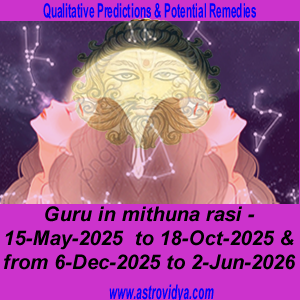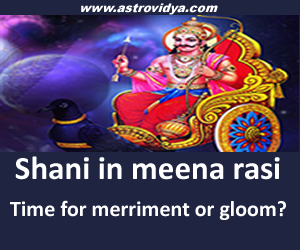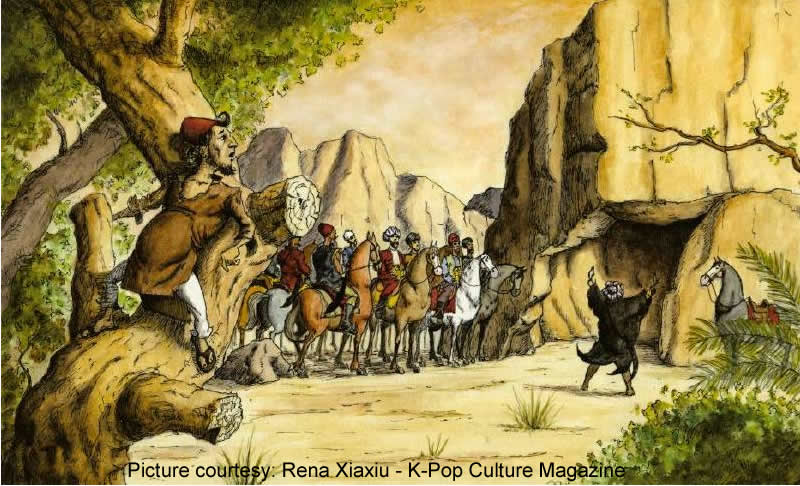




Disclaimer:
"यथोक्तं शास्त्रवाक्येषु श्रद्धया युक्तया सह स्वविवेकेन यः पश्येत् स धर्मं समुपैति ही" --सुभाषितम्
“One who perceives the teachings of the scriptures with both faith and reason, guided by personal discernment, truly attains dharma" - Subhashitam
All material on the site, www.astrovidya.com are for entertainment purposes only and no guarantee is implied as to the accuracy of contents or advertisements contained in or linked to this website. The contents are based on ancient cannons of astrology and should not be interpreted as legal, financial, political, religious, ethical, medical, psychological, psychiatric or any other specialist advice. The user is wholly responsible for his choices, decisions, judgments and risks. In no event shall the site be liable for any direct, indirect, incidental, punitive or consequential damages of any kind whatsoever with respect to its service, materials and products. By using the services you confirm that you are over 18 and that you understand and agree with these terms of Disclaimer. If you disagree with any part of these terms and conditions, please egress the website.
"यथोक्तं शास्त्रवाक्येषु श्रद्धया युक्तया सह स्वविवेकेन यः पश्येत् स धर्मं समुपैति ही" --सुभाषितम्
“One who perceives the teachings of the scriptures with both faith and reason, guided by personal discernment, truly attains dharma" - Subhashitam
All material on the site, www.astrovidya.com are for entertainment purposes only and no guarantee is implied as to the accuracy of contents or advertisements contained in or linked to this website. The contents are based on ancient cannons of astrology and should not be interpreted as legal, financial, political, religious, ethical, medical, psychological, psychiatric or any other specialist advice. The user is wholly responsible for his choices, decisions, judgments and risks. In no event shall the site be liable for any direct, indirect, incidental, punitive or consequential damages of any kind whatsoever with respect to its service, materials and products. By using the services you confirm that you are over 18 and that you understand and agree with these terms of Disclaimer. If you disagree with any part of these terms and conditions, please egress the website.
SPECIALTY OF INDIAN ASTROLOGY

There are several differences between western and Hindu methods. Western astrologers follow a system of presenting the planets as they are in the sky, which is known as sayana system. Hindu astrologers follow nirayana system wherein the shift of the earth is taken off called ayanamsha. Earth would not occupy the same position after say, 366 days. There will be a difference of appx. 50" of arc per year. As this reference plane will be changing, Hindus follow fixed zodiac. The time when the two zodiacs coincided (0 degree ayanamsha) is a point of dispute. There are broadly speaking 3 ayanamshas, Raman, KP and Lahiri. By my experience spread over several years, I finally decided to adopt Lahiri ayanamsha - after conducting many observations on the charts, which would remarkably change when different ayanamshas were used. For convenience sake, the Lahiri ayanamsha found in ephemeris are rounded off. I would rather calculate the desired ayanamsha on an excel sheet and use that in my calculations. Fortunately, some soft wares have provision to make corrections to ayanamsha.
In Hindu system, there are several time scales called dashas. These are sub divided into antardasas (bhuktis). Some of the dashas are: Vimshottari (120 years), tribhagi (wherein vimshottari periods are divided by 3), astottari (108 years), Shodashottari (116 years), Chaturvimshottari (124 years), Shatabdika (100 years), shashtyayini (60 years), dwadashottari (112 years) in addition to Kalachakra dasha, Chara, Stira, Nirayana-sula dashas of Jaimini system. Vimshottari dasha that treats the human life span to 120 years is most reliable one and is also widely followed. My rationalist friend (who has kept One Lakh Rupees challenge to astrologers) finds that Astrologers use these time scales to "suite their needs". I would propose an analogy with the transmission of light. Light traveling in a straight-line principle explains how a sharp shadow is formed while the ware theory of transmission explains whom the same light moves to form semi-shadows like the illumination inside the house! Nirayana-sula dasha sees the life in a different perspective whereas vimshottari in other! Being a practicing astrologer of long standing, I find that Vimshottari dasha covers most aspects of life. Perhaps, you may like other systems as well. Each period begins with reference to the moon's position in a certain star. The results of the periods and sub periods are got by a study of position, inter relationship, ownership, association etc., this time scale is not found in the Western system. Jaimini system employs stira, chara and sula dashas and in this system, the signs (rasis) aspect each other and not planets! My rationalist friend has not thought of this concept as he has gone through Jaimini Sutra. Divisional charts are derived from the basic chart. Navamsha, dasamsha, saptamsha etc, are generated by certain rules and these divisional charts are used to study a particular branch of life like dasamsha is used to study the professional front of the native.
Followers of Jaimini system as well as sayana (western) system are very few in India. In Hindu system, the transit of planets are considered with reference to the moon sign. In western system there are no such elaborate literature and it is merely aspects formed by the planets with reference to cusp points. Here also, 180 degree (mutual aspect) is considered as "difficult' (evil) transit, whereas in the Hindu astrology, mutual aspect is not considered so. In western system, the mutual aspect of guru and shukra (both benefic planets) is said to be evil one. But, in Hindu astrology it is an excellent aspect. In my humble opinion., I found the Hindu method of transit more accurate. Hindu astrology has well developed methods for matching charts for marriage/business partnership. Election astrology (muhurta) is well developed in Hindu astrology by study of stellar behavior. In western system, the matching is done merely by characteristics of signs like watery, fiery, etc, and muturtha is done with reference to significators of the natal chart.
Followers of Jaimini system as well as sayana (western) system are very few in India. In Hindu system, the transit of planets are considered with reference to the moon sign. In western system there are no such elaborate literature and it is merely aspects formed by the planets with reference to cusp points. Here also, 180 degree (mutual aspect) is considered as "difficult' (evil) transit, whereas in the Hindu astrology, mutual aspect is not considered so. In western system, the mutual aspect of guru and shukra (both benefic planets) is said to be evil one. But, in Hindu astrology it is an excellent aspect. In my humble opinion., I found the Hindu method of transit more accurate. Hindu astrology has well developed methods for matching charts for marriage/business partnership. Election astrology (muhurta) is well developed in Hindu astrology by study of stellar behavior. In western system, the matching is done merely by characteristics of signs like watery, fiery, etc, and muturtha is done with reference to significators of the natal chart.
In western system the annual chart used to find the results of a year from birth day to next birth day is merely a simple mathematical progression of natal chart. But, the Hindu system uses different charts as on birth day, a chart is made for the time when Sun enters the same position as in the natal chart and position of other planets are found out. Even a dasha system is used.
When it comes to mundane charts, in western world charts are made for a new year which eventually begins at zero hours standard time of a country which is in no way related to planetary movement, not even on Sun! Hindus celebrate new year Ugadi when Sun and Moon are together i.e. the new year beings when the distance between Sun and Moon is zero degree and there should be a full moon in the star Chitra afterwards. I am belittling the Western system, I am comparing the tool boxes. Hindus have a good tool box and the Westerner's is still primitive. Astrologer should know when and how to use them. Otherwise tool box becomes a show piece like the big law manuals in my lawyer's office - unused, untouched but useful to impress others!
There is so much we should learn from our western counterparts. We simply put the board "so-and-so astrology research centre". What research went on by Dr. so and so Ph.D? He was busy matching the charts. The name of his studio was very impressive. Even after 25 years of practice, I can not call myself a research scholar. I am glad many of my juniors are in research or have already completed. A western astrologer uses the word 'research' with due respect and care. He will not say, "Ma gurugaru itla upadeshincharu, but I do not know whether it works". He speaks for himself. He avoids quoting without his own comments. Not only in astrology in any field, the westerner has lot of dedication and tries to achieve near perfection. Hindus listen to all the religious lectures by all the swamijis for 365 days of the year but do not put a single moral to practice!
When it comes to mundane charts, in western world charts are made for a new year which eventually begins at zero hours standard time of a country which is in no way related to planetary movement, not even on Sun! Hindus celebrate new year Ugadi when Sun and Moon are together i.e. the new year beings when the distance between Sun and Moon is zero degree and there should be a full moon in the star Chitra afterwards. I am belittling the Western system, I am comparing the tool boxes. Hindus have a good tool box and the Westerner's is still primitive. Astrologer should know when and how to use them. Otherwise tool box becomes a show piece like the big law manuals in my lawyer's office - unused, untouched but useful to impress others!
There is so much we should learn from our western counterparts. We simply put the board "so-and-so astrology research centre". What research went on by Dr. so and so Ph.D? He was busy matching the charts. The name of his studio was very impressive. Even after 25 years of practice, I can not call myself a research scholar. I am glad many of my juniors are in research or have already completed. A western astrologer uses the word 'research' with due respect and care. He will not say, "Ma gurugaru itla upadeshincharu, but I do not know whether it works". He speaks for himself. He avoids quoting without his own comments. Not only in astrology in any field, the westerner has lot of dedication and tries to achieve near perfection. Hindus listen to all the religious lectures by all the swamijis for 365 days of the year but do not put a single moral to practice!
















